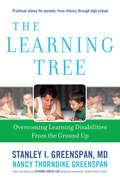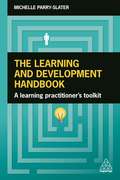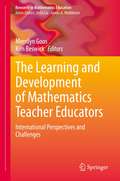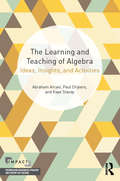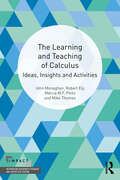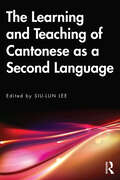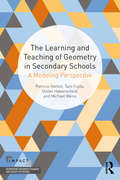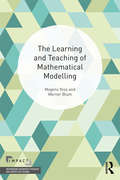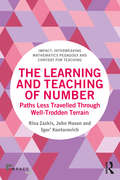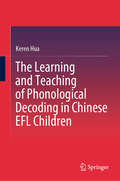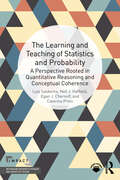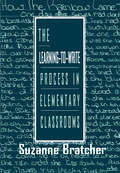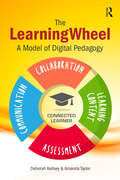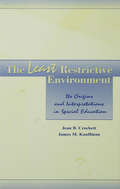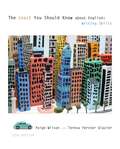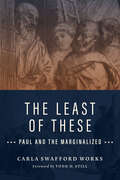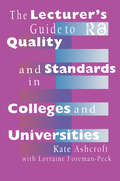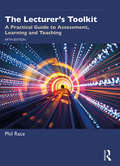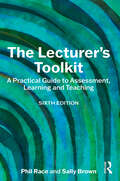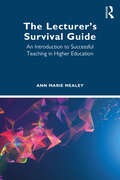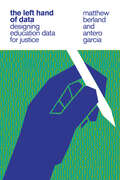- Table View
- List View
The Learning Tree: Overcoming Learning Disabilities from the Ground Up (A Merloyd Lawrence Book)
by Stanley I. Greenspan Nancy Thorndike GreenspanThe internationally admired author of "Engaging Autism" shows parents how to get to the roots of learning disabilities and unleash each childOCOs intellectual potential
The Learning and Development Handbook: A Learning Practitioner's Toolkit
by Michelle Parry-SlaterThe skills needed in today's business world are not the same as they were in the past. Therefore, upskilling, reskilling and developing staff has never been more important. However, classroom training isn't the best way to achieve this with employees forgetting more than 70% of what they've been taught within just one day. Learning outside the workplace is social, digital and immediate and companies need to embrace this to achieve the productivity, performance and revenue benefits that come from effective learning. The Learning and Development Handbook is a practical guide for L&D professionals wanting to move away from traditional classroom teaching but not sure where to start. Full of practical tips and advice, this is urgent reading for anyone in the learning profession.The Learning and Development Handbook includes advice on how to embed social and digital learning, make the most of blended learning, adopt brain-friendly learning and design more effective learning content for improved employee engagement and performance. This book also provides guidance on how to identify learning needs in an organization, gather evidence to engage stakeholders and align L&D strategy with overall business strategy. There is also expert guidance on how to evaluate and measure the effectiveness of learning, where to find the data needed to support learning activity. Written by an L&D practitioner, for L&D practitioners, this book is packed full of tips, hints, tools and models that can be used to improve both employee and overall business performance in the immediate, middle-term and long-term future.
The Learning and Development of Mathematics Teacher Educators: International Perspectives and Challenges (Research in Mathematics Education)
by Merrilyn Goos Kim BeswickResearch in mathematics teacher education as a distinctive field of inquiry has grown substantially over the past 10-15 years. Within this field there is emerging interest in how mathematics teacher educators (MTEs) themselves learn and develop. Until recently there were few published studies on this topic, and the processes by which mathematics teacher educators learn, and the forms of knowledge they require for effective practice, had not been systematically investigated. However, researchers in mathematics education are now beginning to investigate the development of MTE expertise and associated issues. This volume draws on the latest research and thinking in this area is therefore timely to stimulate future development and directions. It will survey the emerging field of inquiry in mathematics education, combining the work of established scholars with perspectives of newcomers to the field, with the aim of influencing development of the field, invite cross-cultural comparisons in becoming a mathematics teacher educator by highlighting issues in the development of MTEs in different countries, and examine the roles of both mathematics educators and mathematicians in preparing future teachers of mathematics. The primary audience will be university-based mathematics teacher educators and MTE researchers, and postgraduate research students who are seeking academic careers as MTEs. Additional interest may come from teacher educators in disciplines other than mathematics, and education policy makers responsible for accreditation and quality control of initial teacher education programs.
The Learning and Teaching of Algebra: Ideas, Insights and Activities (IMPACT: Interweaving Mathematics Pedagogy and Content for Teaching #8)
by Kaye Stacey Paul Drijvers Abraham ArcaviIMPACT (Interweaving Mathematics Pedagogy and Content for Teaching) is an exciting new series of texts for teacher education which aims to advance the learning and teaching of mathematics by integrating mathematics content with the broader research and theoretical base of mathematics education. The Learning and Teaching of Algebra provides a pedagogical framework for the teaching and learning of algebra grounded in theory and research. Areas covered include: • Algebra: Setting the Scene • Some Lessons From History • Seeing Algebra Through the Eyes of a Learner • Emphases in Algebra Teaching • Algebra Education in the Digital Era This guide will be essential reading for trainee and qualified teachers of mathematics, graduate students, curriculum developers, researchers and all those who are interested in the "problématique" of teaching and learning algebra. It allows you to get involved in the wealth of knowledge that teachers can draw upon to assist learners, helping you gain the insights that mastering algebra provides.
The Learning and Teaching of Calculus: Ideas, Insights and Activities (IMPACT: Interweaving Mathematics Pedagogy and Content for Teaching)
by Mike Thomas John Monaghan Robert Ely Márcia M.F. PintoThis book is for people who teach calculus – and especially for people who teach student teachers, who will in turn teach calculus. The calculus considered is elementary calculus of a single variable. The book interweaves ideas for teaching with calculus content and provides a reader-friendly overview of research on learning and teaching calculus along with questions on educational and mathematical discussion topics. Written by a group of international authors with extensive experience in teaching and research on learning/teaching calculus both at the school and university levels, the book offers a variety of approaches to the teaching of calculus so that you can decide the approach for you. Topics covered include A history of calculus and how calculus differs over countries today Making sense of limits and continuity, differentiation, integration and the fundamental theorem of calculus (chapters on these areas form the bulk of the book) The ordering of calculus concepts (should limits come first?) Applications of calculus (including differential equations). The final chapter looks beyond elementary calculus. Recurring themes across chapters include whether to take a limit or a differential/infinitesimal approach to calculus and the use of digital technology in the learning and teaching of calculus. This book is essential reading for mathematics teacher trainers everywhere.
The Learning and Teaching of Cantonese as a Second Language
by Siu-Lun LeeThe Learning and Teaching of Cantonese as a Second Language brings together contributions on such issues as Cantonese textbooks, linguistic description, literacy and tone acquisition, supplemented by case studies from the Netherlands and Japan. The learning and teaching of Cantonese as a second language is a subject of considerable interest in the international academic community, and the first international symposium on teaching Cantonese as a second language, held at the Chinese University of Hong Kong in October 2019, brought together leading researchers in this field. This conference provided the inspiration for the current volume, The Learning and Teaching of Cantonese as a Second Language. In the Hong Kong context, historically, the term ‘Cantonese’ refers to the language varieties of immigrants who came to the territory from various areas in Guangdong province, including Macau, Panyu, Taishan, Xinhui and Zhongshan. From the late nineteenth century onwards, their speech coalesced into the contemporary variety of Cantonese used in Hong Kong today. The term ‘Cantonese’ is also used to refer to the entire Yue subgroup of Chinese, which includes varieties of Cantonese spoken in southern China, Hong Kong, Macau, Malaysia, Singapore and among overseas Chinese in Australia, Europe and North America. In all, it is estimated that there are about 70 million Cantonese speakers in the world. This volume is of direct relevance to educators, language teachers, linguists and all those concerned with the learning of Cantonese as a second language.
The Learning and Teaching of Geometry in Secondary Schools: A Modeling Perspective (IMPACT: Interweaving Mathematics Pedagogy and Content for Teaching)
by Michael Weiss Taro Fujita Stefan Halverscheid Pat HerbstIMPACT (Interweaving Mathematics Pedagogy and Content for Teaching) is an exciting new series of texts for teacher education which aims to advance the learning and teaching of mathematics by integrating mathematics content with the broader research and theoretical base of mathematics education. The Learning and Teaching of Geometry in Secondary Schools reviews past and present research on the teaching and learning of geometry in secondary schools and proposes an approach for design research on secondary geometry instruction. Areas covered include: teaching and learning secondary geometry through history; the representations of geometric figures; students’ cognition in geometry; teacher knowledge, practice and, beliefs; teaching strategies, instructional improvement, and classroom interventions; research designs and problems for secondary geometry. Drawing on a team of international authors, this new text will be essential reading for experienced teachers of mathematics, graduate students, curriculum developers, researchers, and all those interested in exploring students’ study of geometry in secondary schools.
The Learning and Teaching of Mathematical Modelling: Ictma14 (IMPACT: Interweaving Mathematics Pedagogy and Content for Teaching #1)
by Werner Blum Mogens NissThis book takes stock of the state of affairs of the teaching and learning of mathematical modelling with regard to research, development and practice. It provides a conceptual framework for mathematical modelling in mathematics education at all education levels, as well as the background and resources for teachers to acquire the knowledge and competencies that will allow them to successfully include modelling in their teaching, with an emphasis on the secondary school level. Mathematics teachers, mathematics education researchers and developers will benefit from this book. Expertly written and researched, this book includes a comprehensive overview of research results in the field, an exposition of the educational goals associated with modelling, the essential components of modelling competency and an extensive discussion of didacticopedagogical challenges in modelling. Moreover, it offers a wide variety of illuminating cases and best-practice examples in addition to insights into the focal points for future research and practice. The Learning and Teaching of Mathematical Modelling is an invaluable resource for teachers, researchers, textbook authors, secondary school mathematics teachers, undergraduate and graduate students of mathematics as well as student teachers.
The Learning and Teaching of Number: Paths Less Travelled Through Well-Trodden Terrain (IMPACT: Interweaving Mathematics Pedagogy and Content for Teaching)
by John Mason Rina Zazkis Igor' KontorovichNumbers are the backbones of mathematics. From 1 to infinity, numbers accompany and underlie the learning of mathematics and research. While perceived as familiar and understood, numbers present fascinating and often mysterious patterns, relationships and pedagogical issues. The Learning and Teaching of Number explores how mathematics education research has addressed issues related to the structure of numbers and number operations and provides a classroom context. It invites readers to explore less-travelled paths through a well-trodden terrain of number. This fascinating book combines mathematical content with pedagogical ideas and research results. Focusing on number, the book illustrates central ideas related to numbers via a variety of tasks at different levels of complexity. The Learning and Teaching of Number will allow the reader to examine and develop personal understanding of number sets and the relationships among them; enhance personal understanding of familiar topics associated with number operations; engage in a variety of tasks and strengthen personal problem-solving skills; enrich their repertoire of mathematical tasks and pedagogical actions; and consider research ideas and results related to teaching numbers, number operations and number relationships. This is a valuable resource for teacher education courses, graduate programs in mathematics education and professional development programs. Teacher trainers and maths teachers will find their personal understanding of numbers and relationships enriched and will draw connections between research and classroom pedagogy which will extend and enhance their teaching.
The Learning and Teaching of Phonological Decoding in Chinese EFL Children
by Keren HuaThis book presents the learning and teaching of phonological decoding in Chinese EFL primary classrooms. The phonological decoding ability of the children is described, interpreted, and evaluated, the teaching materials are analyzed and the classroom instruction observed, and the links between these various facets are explored using both quantitative and qualitative techniques (textbook analysis, classroom observations, interviews with teachers and a textbook writer, reading test and nonword reading test). This book provides insights into Chinese children’s phonological decoding profile, including performance in decoding different types of orthographic units, the strategies children at different levels of reading ability use to sound out vowel graphemes, and their decoding ability in relation to reading ability. The investigation of the teaching practices reveals how the decoding instruction is designed, developed, and delivered to the children and thereby informs the interplay between the classroom instruction and children’s development of phonological decoding skills.
The Learning and Teaching of Statistics and Probability: A Perspective Rooted in Quantitative Reasoning and Conceptual Coherence (IMPACT: Interweaving Mathematics Pedagogy and Content for Teaching)
by Egan J Chernoff Luis Saldanha Neil J. Hatfield Caterina PrimiFilled with practical learning activities to adopt within your classroom, The Learning and Teaching of Statistics and Probability places reasoning about quantities and quantification at the core of learning and teaching statistics. A companion website to this book is also available at https://neilhatfield.github.io/IMPACT_Statistics/, allowing readers to access a directory of resources – data collections and web-based applets – used in some of the instructional activities featured within this book. Through its presentation of conceptual analyses and resources for teaching with statistical data, the book’s five chapters establish key concepts and foundational ideas in statistics and probability, emphasizing the development of learner understanding and coherence, for example: Individual cases and their attributes Data collections, sub-collections, and relevant operations to quantify their attributes Samples, population, and quantifying variation Types of processes, meanings of randomness, and probability as a measure of stochastic tendency Sampling distributions and statistical inference. This highly informative yet practical book is an indispensable resource for teachers of secondary school mathematics, mathematics subject leads, and mathematics and statistics educators within the wider field of education.
The Learning-Centered Kindergarten: 10 Keys to Success for Standards-Based Classrooms
by Shari Y. EhlyThis innovative book helps kindergarten teachers align learning-centered practices with state standards and offers classroom vignettes, practical strategies, lesson plans, and other essential resources.
The Learning-to-write Process in Elementary Classrooms
by Suzanne BratcherThis text models for teachers how to help children learn and write by establishing comfort with writing, building confidence, and developing competence. Several themes run through the learning-to-write-process presented in this text:* Writing is communication;* Writing is a powerful tool for learning;* How children feel about their writing and themselves as writers affects how they learn to write;* Teachers are coworkers with students; children from many backgrounds can learn to write together. The text sythesizes what we know about how children learn, how we write, and what we write into a process of teaching children to write. It is intended to serve as a starting place for developing theories of how to best teach writing.
The LearningWheel: A model of digital pedagogy
by Deborah Kellsey Amanda Taylor-BeswickGiven the influence of digital technologies on the world at large education and educators are yet again being forced to consider their educational practices. Not all educators have been socialised professionally to use technologies and therefore knowledge gaps exist. This book adds to emerging conversations about the use of technologies to support and indeed replace traditional teaching methodologies in a range of educational settings. It offers an example of innovative approach ‘LearningWheel’ to bridge the afore mentioned knowledge gap and provides an opportunity for readers to engage with technologies for teaching and learning purposes.Beginning with an outline of how technologies are shaping the learning landscape more broadly each subsequent chapter takes on a layer of the LearningWheel and sets it in context from a theoretical position. An example wheel is included in each chapter, as are stop and pause questions to prompt educators to engage with the content in a very real sense. By the end of the book readers will have had the opportunity to connect with the LearningWheel (VCoP) in the development of a Learning Wheel unique to this book.
The Least Restrictive Environment: Its Origins and interpretations in Special Education (The LEA Series on Special Education and Disability)
by James M. Kauffman Jean B. CrockettThe Least Restrictive Environment: Its Origins and Interpretations in Special Education examines issues of ethical leadership and clarifies instructional placement decisions that provide a full educational opportunity for students with disabilities.
The Least You Should Know about English: Writing Skills, Twelfth Edition
by Teresa Ferster Glazier Paige WilsonQuickly master English writing skills with THE LEAST YOU SHOULD KNOW ABOUT ENGLISH: WRITING SKILLS, Twelfth Edition. Brief and uncomplicated, this text has helped students learn the basics of English writing for more than 30 years with its clear, concise concept explanations and useful, relevant corresponding exercises. Topics include spelling, word choice, sentence structure, punctuation, paragraph, and essay writing-as well as more advanced skills such as argumentation and quotation. Check your work easily with exercise answers located in the back of the book, making it an excellent writing resource even after the course has ended.
The Least of These: Paul and the Marginalized
by Carla Swafford WorksJesus cared for the least, but did Paul?The apostle Paul has a reputation for being detached from the concerns of the poor and powerless. In this book, Carla Swafford Works demonstrates that Paul&’s message and ministry are in harmony with the teaching of Jesus. She brings to light an apostle who preaches and models good news to the &“least of these&”—the poor, the marginalized, the disadvantaged, and the vulnerable. The Least of These begins by highlighting the presence of the marginalized in Paul&’s ministry by looking at poverty in Paul&’s churches, the involvement of slaves and freedpersons in the community, and the role of women in the Pauline mission. Works then examines the significance of the marginalized in Pauline theology by investigating how the apostle employs metaphors of the &“least.&” Like Jesus, Paul cared deeply for people at the margins. Paul&’s ministry is consistent with that of Jesus. Both men cared for the poor. Paul served the least in his mission, modeling his apostolic ministry after the cross of Christ. Works shows that Paul, far from being an abstract thinker, was a practical theologian teaching a message and leading a life of compassion, kindness, and care.
The Leather Apron Club: Benjamin Franklin, His Son Billy & America's First Circulating Library
by Jane YolenA powerful celebration of libraries from master storyteller Jane Yolen. Benjamin Franklin introduces his son Billy to the Leather Apron Club, where it's love at first page.When Billy's father Benjamin Franklin announces that Billy and his lazy cousin James will soon have a tutor, Billy is initially dismayed. But his tutor awakens him to the power of story and books, and when Billy accompanies his father to the Leather Apron Club (which Franklin started in 1727), he decides to do more with his education and life. Best-selling author Jane Yolen introduces readers to the Leather Apron Club. Not only was the Club the first successful lending library in the United States--it also exists to this day as the Library Company of Philadelphia! Careful readers will notice that the story cleverly incorporates famous sayings from Ben Franklin's Poor Richard's Almanack, underscoring the lasting impact of words.
The Lecturer's Guide to Quality and Standards in Colleges and Universities
by Kate Ashcroft Lorraine Foreman-Peck Professor Kate Ashcroft Dr Lorraine Foreman-PeckA follow-up volume to "Managing Teaching and Learning in Further Education and Higher Education", this text provides a guide to managing quality and standards from the lecturer's point of view. It covers key issues such as teaching, learning, student support, assessment, evaluation, course design, bidding for and managing resources, marketing and research.; Based on the model of lecturer as reflective practitioner, this book is intended to help enable the lecturer to make sense of the changing climate of quality control and academic standards. Its interactive design introduces stimulating ideas and suggestions for further reading and provides guidelines on issues of relevance to individual readers.
The Lecturer's Toolkit: A Practical Guide to Assessment, Learning and Teaching
by Phil RaceThe Lecturer’s Toolkit is the primary resource for all teachers in higher education, whatever their experience, who are seeking to improve their teaching skills. Developed around detailed, practical guidance on the core elements of effective teaching in HE, it is packed full of accessible advice and helpful tips. This fully updated edition covers key topics including: learning styles assessment lecturing personal management skills formative feedback large and small group teaching blended learning resource based and online learning peer observation of teaching. The Lecturer’s Toolkit is essential for anyone working towards a profesisonal qualification in teaching in higher education as well as for those who want to reflect on and develop existing skills.
The Lecturer's Toolkit: A Practical Guide to Assessment, Learning and Teaching
by Phil RaceThe fifth edition of The Lecturer’s Toolkit addresses the needs and aspirations of all lecturers teaching in tertiary education. With a focus on practical, implementable strategies to enhance learning experiences and ensure best practice, it covers all of the need-to-know information crucial to teaching success. Pinpointing aspects of teaching excellence, the challenges and stresses of teaching and adapted to cover digital and online learning as well as face-to-face contexts, this new edition covers: designing and using learning outcomes face-to-face, online and peer dialogues using web extracts, video-clips, phones, tablets and social media in large group teaching how online learning relates to the larger contexts of lectures and MOOCs cheating, plagiarism, essay mills and online assessment how particular aspects fit into the bigger picture of a module/course/degree/life ensuring you’re looking after yourself Based on four decades of experience of higher education, The Lecturer’s Toolkit is written with authority and clarity in a jargon-free style. This invaluable guide is a must-read for every higher education professional.
The Lecturer's Toolkit: A Practical Guide to Assessment, Learning and Teaching
by Phil Race Sally BrownWith a focus on practical, implementable strategies to enhance learning experiences, the extensively updated sixth edition of The Lecturer’s Toolkit is an essential guide for those new to teaching in Higher Education, as well as a companion to improve the practice of more experienced teachers.Centred around the Race model of learning, which proposes a pragmatic exploration of how students learn, it offers research-informed practical tips and advice, with question prompts to cement knowledge, key tips to enhance best practice, and chapter outcomes to help shape learning. This edition has been fully updated to recognise changing approaches to higher education learning including online and distance learning and consideration of how of AI and Large Language Models are impacting on ways of teaching and assessing students. Covering all of the need-to-know information that is essential to thrive in tertiary teaching environments, this book includes information on: Understanding how students really learn, including online and hybrid learning Ways to increase student motivation and engagement Ways to design assessments that are both authentic and compassionate Pragmatic and positive ways of using feedback to enhance learning Practical advice on large and small group teaching Advice on looking after yourself in stressful working contexts Some thoughts on where higher education is moving next. This accessible toolkit is based on decades of experience of higher education and is written with authority and clarity in a jargon-free style. An invaluable guide, it is a must-read for every higher education professional.
The Lecturer's Toolkit: A practical guide to assessment, learning and teaching
by Phil RaceThe Lecturer’s Toolkit is a wide-ranging, down-to-earth, practical resource for lecturers and teachers in universities and colleges. Jargon-free and written with authority, clarity and candour, the Toolkit addresses a broad range of aspects of assessment, feedback, learning and teaching, and helps develop many facets of professional practice. Built around a central agenda of improving the quality of student learning, the Toolkit is outcomes-focused. Building on the strengths of its predecessors, this fourth edition includes strengthened emphasis on assessment and feedback, and designing large-group teaching for the digital age, when students can get easy access to a vast range of learning resource materials online. Coverage includes: how students really learn; designing assessment and feedback to enhance learning; lectures in the digital age; making small-group teaching work; resource-based learning in the digital age; looking after yourself; challenges and reflections. Fully updated and expanded, this fourth edition of the Toolkit will be an essential and flexible resource for every higher education professional.
The Lecturer’s Survival Guide: An Introduction to Successful Teaching in Higher Education
by Ann Marie MealeyServing as a comprehensive introduction to those new to teaching in higher education, this essential guide discusses pedagogical approaches that are current in higher education and the wider responsibilities of teaching within higher education. This book outlines the key aspects of navigating the role, including becoming a personal tutor and supporting the needs of a diverse student body. Readers will benefit from advice on promoting wellness, best practice while teaching and enjoying their role as they embark on their first academic job. It also underlines throughout that all lecturers need to be guided by a set of values around respect for students and the need to create learning environments that move away from any ‘ghetto’ style approaches to higher education. It suggests that our values as lecturers are key to us creating and exemplifying the much-needed ethical and just practice in our classrooms so that they mirror the kind of society we would like to live in and enable every student to feel as though they ‘belong’ at university. Written in an informative yet accessible manner, chapters explore the following: The challenges of transitioning from student to lecturer The key theories that underpin successful curriculum design Assessment and feedback as a source of empowerment within higher education teaching The need for academic personal tutoring Staying well when teaching within higher education Written for those who are new to higher education or to teaching in this setting, The Lecturer’s Survival Guide is an essential read for any higher education teacher who wishes to ensure successful teaching whilst maintaining a healthy work-life balance.
The Left Hand of Data: Designing Education Data for Justice
by Antero Garcia Matthew BerlandA speculative framework that imagines how we can use education data to promote play, creativity, and social justice over normativity and conformity.Educational analytics tend toward aggregation, asking what a &“normative&” learner does. In The Left Hand of Data, educational researchers Matthew Berland and Antero Garcia start from a different assumption—that outliers are, and must be treated as, valued individuals. Berland and Garcia argue that the aim of analytics should not be about enforcing and entrenching norms but about using data science to break new ground and enable play and creativity. From this speculative vantage point, they ask how we can go about living alongside data in a better way, in a more just way, while also building on the existing technologies and our knowledge of the present.The Left Hand of Data explores the many ways in which we use data to shape the possible futures of young people—in schools, in informal learning environments, in colleges, in libraries, and with educational games. It considers the processes by which students are sorted, labeled, categorized, and intervened upon using the bevy of data extracted and collected from individuals and groups, anonymously or identifiably. When, how, and with what biases are these data collected and utilized? What decisions must educational researchers make around data in an era of high-stakes assessment, surveillance, and rising inequities tied to race, class, gender, and other intersectional factors? How are these complex considerations around data changing in the rapidly evolving world of machine learning, AI, and emerging fields of educational data science? The surprising answers the authors discover in their research make clear that we do not need to wait for a hazy tomorrow to do better today.
